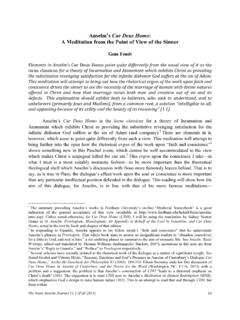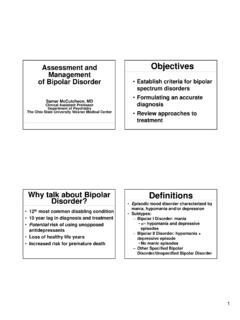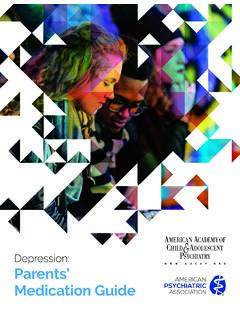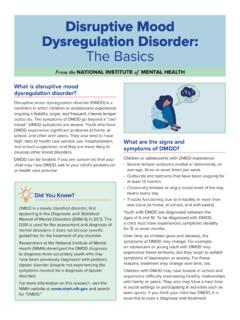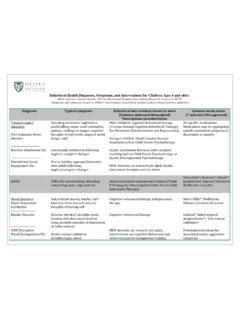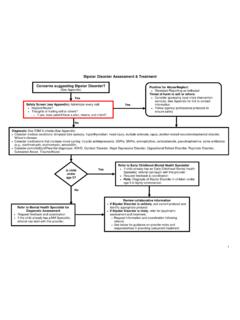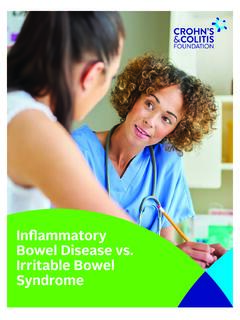Transcription of TREATMENT PLAN DEVELOPMENT: BIPOLAR DISORDER
1 3/26/2018 1 TREATMENT OF RAPID-CYCLING BIPOLAR DISORDER PAMELA MARCUS, RN,APRN/PMH/BC 14460 Old Mill Rd. #201 Upper Marlboro, Maryland 20772 CONFLICT OF INTEREST Ms. Marcus has no conflicts of interest. There are no discussions of off-label medications in this presentation OBJECTIVES Differentiate between symptoms manifested by individuals with BIPOLAR I, BIPOLAR II, and Mixed BIPOLAR DISORDER , as compared to Rapid-Cycling BIPOLAR DISORDER with case study Describe the medications most often used for patients with BIPOLAR DISORDER OBJECTIVES Identify two nursing interventions that are most helpful when providing psycho-education for patients and their families to better understand and manage symptoms of Rapid Cycling BIPOLAR DISORDER .
2 Discussed using case study BIPOLAR DISORDER , OVERVIEW Affects approximately 1% ( million) in the USA, ages 18 and older First manic episode- 18-20 years old Earlier age of onset worse outcomes, including rapid cycling in adulthood Individuals with BIPOLAR DISORDER account for one quarter of all suicidal deaths reported in the general population. BIPOLAR DISORDER BIPOLAR I affects men and women equally BIPOLAR II more common in women Women are more likely to have mixed mania and manic switches during TREATMENT with an antidepressant Rapid cycling: four or more episodes per year Frequent cycling.
3 Two to three episodes a year 3/26/2018 2 BIPOLAR I One or more manic episode alternating with a major depressive episode Manic episode Persistent elevated, expansive or irritable mood Sleep disturbances Increase distracted, restless Impulsive behavior Exaggerated self-esteem BIPOLAR I Manic episodes begin suddenly lasting a few days to a few months Abrupt mood shifts rapid changes from euphoria to anger or depression Individuals with depressive symptoms tend to be less responsive to conventional therapy BIPOLAR II Major depressive episode and one hypomanic episode No history of a manic or mixed episode No psychotic features Hypomanic episodes usually occur before or after a major depressive episode Diagnosis is difficult RAPID CYCLING Four or
4 More manic episodes for at least 2 weeks in a year Have partial or full remission for 2 months or switch to the opposite mood (if manic; switches to depressed mood) High risk of recurrence and resistance to TREATMENT Greater severity of symptoms of mania and depression Theories of Etiology ETIOLOGY:GENETIC BIPOLAR disorders highly inheritable Complex mode of inheritance, involving multiple interacting genes Dysregulation in gene G protein receptor kinase 3 (GRK3) dopamine metabolism Polygenic 3/26/2018 3 ETIOLOGY:GENETIC Genetic: Concordance rates in monozygotic twins 67% ; Dizygotic twins 19%.
5 Research is being done on genetic testing for BIPOLAR DISORDER ; including where the genetic disruption may be occurring Genetic association of serotonin system genes is being conducted NEUROANATOMIC ISSUES Volume reduction in subregion of prefrontal cortex Amygdala and striatal enlargement Midline cerebellar atrophy Enlarged lateral and third ventricle with white matter hyperdensity in 10-30% of individuals with BIPOLAR DISORDER NEUROTRANSMITTERS Increase in sensitivity of postsynaptic receptors Dysregulation in dopamine and serotonin along with deficits in other systems.
6 Such as GABA Signaling pathway abnormalities and altered neurotransmitters; G proteins translate the signals and relay the signals to the second-messenger systems are increased with BIPOLAR DISORDER PSYCHOLOGICAL INFLUENCES Response to biological makeup and coping skills Faulty beliefs about self and the world around them Risks do not have consequences Goal striving euphoria drive increases regardless of feedback from others and disruption in daily routine PSYCHOLOGICAL INFLUENCES Psychosocial stressors trigger BIPOLAR episodes by disruption of usual social rhythms Disruption of circadian systems
7 MEDICATION MANAGEMENT 3/26/2018 4 CHOOSE THE BEST MEDICATION Syndrome targeting (the pattern and stage of the illness) Symptom targeting Awareness of interactions Best drug class Mechanisms of drug action CHOOSE THE BEST MEDICATION Symptoms presented History and patterns of illness Side effect profile Personal and family responses to TREATMENT Cost Ease of administration Onset of action Drug to drug interaction USE OF LITHIUM LiCo3 is an older mood stabilizer, continues to demonstrate good therapeutic results and is seen as the first line TREATMENT for a mood stabilizer MOOD STABILIZER TREATMENT of choice in manic phase LiCo3 and Valproate are the two first line TREATMENT choices Second line alternative is Carbamazepne or LiCo3 and valproate MOOD STABILIZERS Rapid cycling: Valproate; first line Carbamazepine; first line Second line alternative: LiCo3 and valproate LiCo3 LiCo3 and carbamazepine 3/26/2018 5 MOOD STABILIZERS Mixed episode or dysphoric mood: Valproate.
8 First line LiCo3 or Carbamazepine Gabapentin Lamotrigine Topiramate Second line alternative: LiCo3 and valproate ADJUNTIVE MEDICATIONS Manic with psychosis: Therapeutic goal: Control psychosis Induce sleep and sedation ADJUNTIVE MEDICATIONS First line: and a high or medium potency antipsychotic to the mood stabilizer Benzodiazepine may be added to the antipsychotic and mood stabilizer Low potency antipsychotic ADJUNCTIVE MEDICATIONS Severe mania without psychosis Add a benzodiazepine to the mood stabilizer Add a high or medium potency antipsychotic to the mood stabilizer and benzodiazepine.
9 ADJUNTIVE MEDICATIONS Hypomanic: Add a benzodiazepine to the mood stabilizer Add a high or medium potency antipsychotic This is rarely needed, but is sometimes helpful. TREATING THE ACUTE PHASE Major depression with psychotic features: ECT Mood stabilizer and antidepressant with an antipsychotic 3/26/2018 6 TREATING THE ACUTE PHASE Severe major depression, no psychosis: Mood stabilizer and antidepressant Do not use antidepressants as an monotherapy to prevent mania/hypomanic episodes Phototherapy when depression occurs in late fall or winter TREATING THE ACUTE PHASE Milder major depressive episode.
10 Mood stabilizer and an antidepressant Mood stabilizer alone ADJUNCTIVE MEDICATIONS Insomnia: Add benzodiazepine Second line Add trazodone May use a sedating antidepressant ADJUNCTIVE MEDICATIONS Psychotic symptoms in the depression: Add a high or medium potency conventional antipsychotic in addition to the mood stabilizer and antidepressant regimen IMPORTANT ITEMS TO NOTE When starting a patient on an antidepressant for severe depressive episode; note mood changes to determine if the mood has switched into a mania or hypomania If the patient demonstrates manic or hypomanic symptoms, discontinue the antidepressant IMPORTANT ITEMS TO NOTE Check thyriod function studies Individuals with rapid cycling BIPOLAR DISORDER frequently have hypothalamic-pituitary-thyroid axis abnormalities Cytomel 25 to 75 mcg per day (T3) Levothroid 50 to 200 mcg per day (T4)
